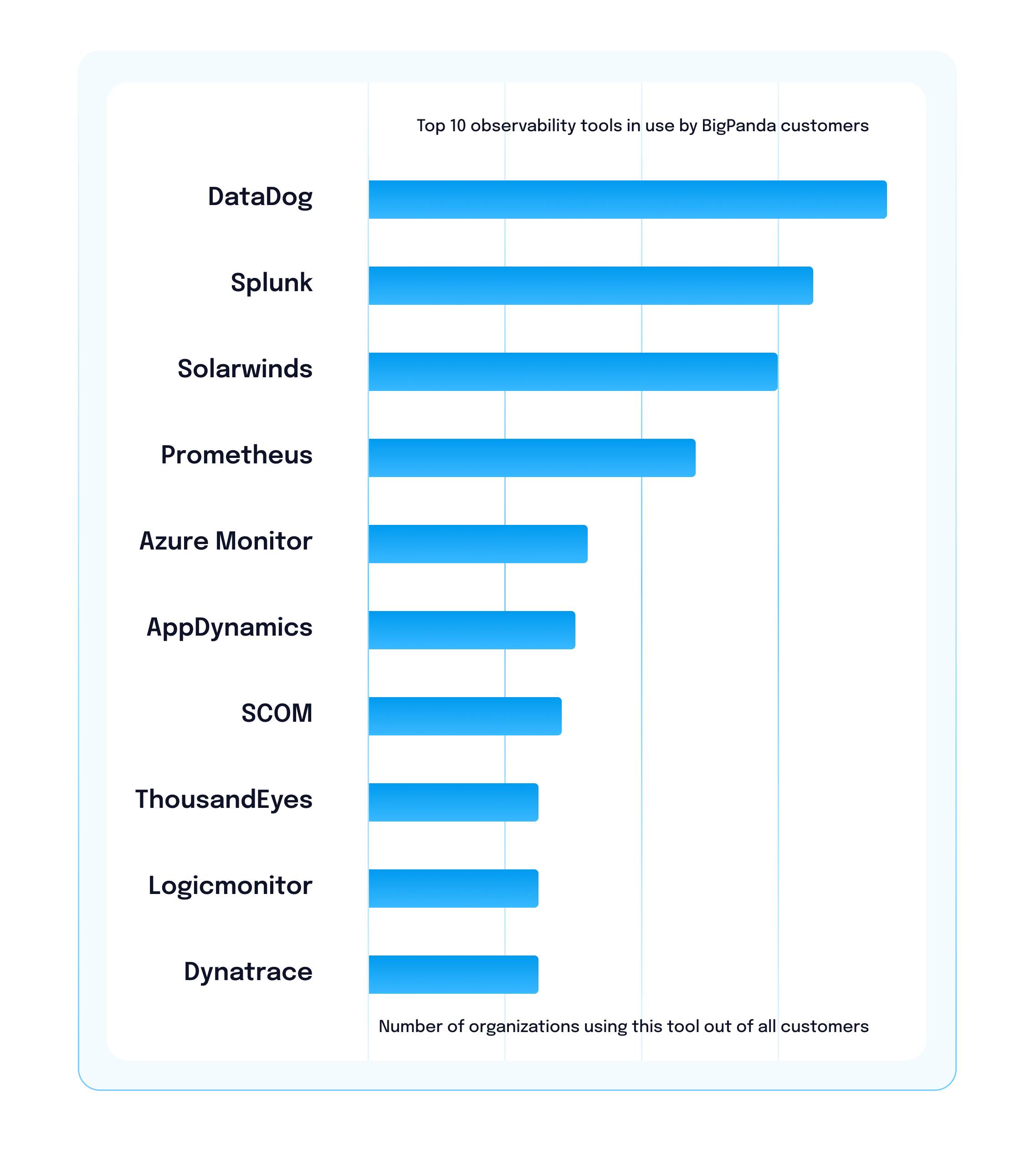Tame complexity: Understand observability tools

Choosing, deploying, maintaining, and rationalizing observability and monitoring tools can be a constant challenge for ITOps, DevOps, and SRE teams. As teams monitor increasingly complex systems, the need for instrumentation that monitors those systems grows at the same rate, leading directly to a growing problem of observability data engineering, integration, and enrichment. BigPanda customers tell us their observability and monitoring software stack changes regularly as they are constantly tuning, refining, adding, and retiring new observability software to meet changing business needs.
With 91% of organizations experiencing challenges when deploying observability software, it can be difficult to benchmark your organization’s efforts against a changing observability vendor landscape.
Although managing multiple observability tools can add complexity, an industry best practice in observability includes the collection of data from a surprising number of observability sources. A recent survey from Enterprise Strategy Group showed most organizations have 6 or more observability solutions, and the average BigPanda customer uses ~20 sources of observability and monitoring data!
What drives observability tool complexity and sprawl?
Why are there so many different observability tools and observability architectures? Speaking with BigPanda customers, the answer varies. But some common reasons include:
- Diverse infrastructure stack: Companies use a mix of technologies, including different programming languages, frameworks, databases, and cloud services. Each technology may have specialized monitoring tools tailored to its specific nuances. This is particularly true if you are in a cloud environment and wish to use the cloud-specific monitoring tools available from your cloud provider.
- Specialized functionality: Different tools excel at specific tasks. Some tools might be excellent for infrastructure monitoring, while others specialize in application performance or network analysis. Security, near-real-time monitoring, and network topology are some specialized capabilities BigPanda customers receive from distinct observability platforms.
- Vendor lock-in concerns: Avoiding vendor lock-in by avoiding single-vendor solutions, especially in cloud environments, ensures flexibility and prevents dependency on a single vendor’s product or ecosystem. Single-vendor solutions can limit access to innovative new technologies.
- Legacy systems: IT teams operate legacy systems that can require specific monitoring solutions. Often custom observability tools may be needed to accommodate legacy infrastructure.
- Scalability and performance: Large enterprises may require differently scalable solutions to handle varying amounts of monitoring data. Different tools are based on their ability to scale and perform efficiently under different loads and data volumes. Near-real-time performance is a common requirement, particularly for security applications.
- Comprehensive observability: No single tool provides comprehensive observability across the entire technology stack. Companies use a combination of tools to achieve end-to-end visibility, including infrastructure, applications, user experience, and security aspects.
This last reason, the need for comprehensive observability, is why BigPanda is so valuable to operations teams. BigPanda aggregates diverse data sources into a single, powerful platform for incident intelligence and automation. With BigPanda, high-quality and actionable alerts are correlated into distinct incidents and automatically triaged and analyzed using open-box AI/ML.
Another key benefit of BigPanda’s unified view of your observability and monitoring deployments is the ability to control for ongoing changes in your observability toolset. As underlying tools change and evolve, the data is cleaned, normalized, and presented consistently in BigPanda, avoiding the need to retrain teams on new tools, workflows, and interfaces.
Maximize your observability tool investment
Good news, BigPanda can help teams understand the value of alerts from each observability tool they use. BigPanda even helps with the tuning, improvement, and rationalization of observability tools.
BigPanda customers don’t just report using multiple tools, but they report using a wide and changing variety of tools. Beyond out-of-the-box pre-built integrations, BigPanda’s open integration hub allows IT teams to connect to virtually any monitoring tool available. In fact, BigPanda’s open integration capabilities are the most common way to connect monitoring systems to BigPanda.
Understand common observability tools
The most common tools connected to BigPanda and deliver data to the BigPanda data platform are listed below. These top ten integrations are very similar in the number of BigPanda customers using them. There are no clear vendors dominating all areas of observability, and each tool seems to deliver value across a large number of organizations.

These are the 10 most common observability and monitoring tools in use across the BigPanda customer base.
The BigPanda ITOps vendorscape further details the ecosystem of observability and monitoring tools, with many tools beyond those mentioned here. Each can provide distinct value when combined with other data and enriched in BigPanda’s unique data platform. Specific uses for our most popular integrations include:
1. DataDogDataDog provides extensive support for technologies, including cloud platforms, containers, databases, and applications. The integration with BigPanda empowers IT operations teams, site reliability engineers, and DevOps professionals to proactively identify, troubleshoot, and resolve issues across complex, distributed systems.
2. SplunkSplunk excels in real-time analysis, offering a holistic view of IT infrastructure, applications, and user behavior. Splunk data in BigPanda enables rapid problem resolution, improved system performance, enhanced security postures, and streamlined operations.
3. SolarwindsSolarWinds provides in-depth network performance monitoring, fault detection, and robust reporting, enabling quick issue resolution and optimizing system performance. The data it delivers to BigPanda is highly granular and near-real-time, ensuring rapid incident detection, clearer insights, and accelerated incident remediation.
4. PrometheusPrometheus is an open-source monitoring and alerting toolkit designed for reliability and scalability. Prometheus provides real-time monitoring of infrastructure components and applications. ITOps teams can collect and analyze metrics, such as CPU usage, memory utilization, network latency, and request rates, delivering into BigPanda through the integration enabling rapid detection of incidents as they arise.
5. Azure MonitorThe data Azure Monitor supplies is specialized and tailored for Azure services, offering specific metrics and insights unique to Azure’s architecture. IT Operations teams, cloud administrators, and developers can benefit by integrating Azure Monitor data into BigPanda to gain precise, real-time information about their Azure infrastructure.
6. AppDynamicsAppDynamics (part of Cisco Systems) provides application performance monitoring capabilities, increasing visibility into application behavior, transaction traces, and code-level diagnostics. By integrating AppDynamics data into BigPanda, IT teams, DevOps professionals, and developers can optimize application performance, troubleshoot efficiently.
7. Microsoft SCOMMicrosoft System Center Operations Manager (SCOM) provides native monitoring for Microsoft applications and infrastructure, ensuring comprehensive, detailed insights into Windows-based systems. SCOM provides granular data specific to Microsoft environments, including Active Directory, SQL Server, and Exchange, and provides in-depth visibility into the performance and health of these systems.
8. ThousandEyesThousandEyes (also part of Cisco) provides a holistic view of network performance from an external perspective. Unlike many tools that monitor internal infrastructure, ThousandEyes employs a vast network of global agents to simulate user experiences and pinpoint issues across the internet, cloud providers, and various networks. This external vantage provides real-time visibility into network-related problems, enabling quick identification of bottlenecks, outages, or latency.
9. LogicMonitorLogicMonitor can provide crucial observability of technologies and automation capabilities. Its unique value lies in its automated device discovery, mapping, and pre-configured monitoring templates. This simplifies setup and ensures comprehensive coverage of various technologies, particularly automation tooling.
10. DynatraceDynatrace provides real-time, full-stack monitoring across complex systems. The data it provides is often highly contextual and holistic, offering deep insights into user experience, application performance, and infrastructure health. Development, operations, and business teams benefit significantly from this data, gaining the ability to proactively detect, diagnose, and resolve issues, ensuring exceptional user experiences.
Make the most of observability tools
Because BigPanda is observability tool agnostic and has a unique view into your observability and monitoring stack, BigPanda is uniquely able to help you get more out of your observability investments. BigPanda can help you evaluate, tune, and improve your data sources by:
- Identifying the volume and quality of alert data
- Understanding alert actionability – how NOC or SRE teams act on observability alerts
- Gaining additional insights into observability gaps and redundancies
- Pointing you in the right direction to improve observability tools and measure changes
“Don’t wait to start your AIOps journey once you are overwhelmed with alerts. Start early to get a single pane of glass to understand which monitoring tools you really need.”
— Sanjay Chandra, Vice President of IT, Lucid Motors
Watch the Lucid Motors case study
Interested in learning more about BigPanda, how you can get more from your observability and monitoring investments, and make observability more actionable? Request a personalized demo.



